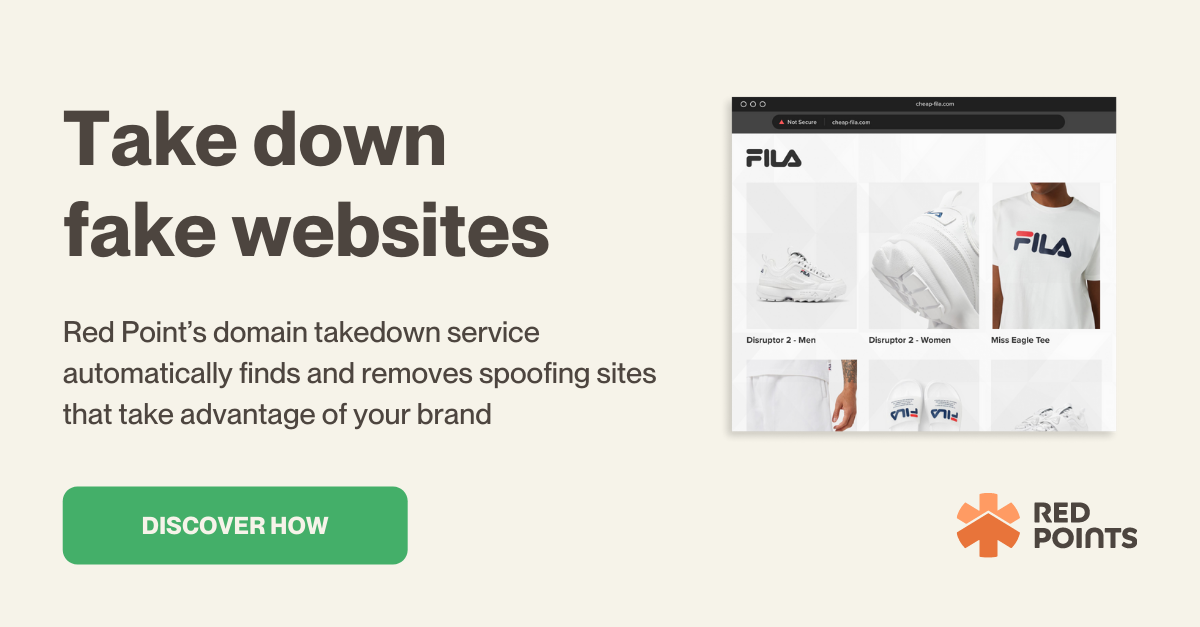
Table of Contents:
Last updated on: November 27, 2023
Discovering that someone has stolen your copyright materials and is using them online can be as stressful as it is infuriating. Getting the infringements taken down is essential to protect your revenue and reputation, but figuring out the best way to do this can be difficult. Luckily, sending a DMCA takedown notice doesn’t have to be stressful or difficult, and we’re breaking down the process to help protect your copyrights.
Summary:

Copyright infringement is the unlawful use of another individual’s or brand’s existing copyrighted work. A copyright grants you legal ownership of your unique creations like products and website design, but it doesn’t necessarily stop people from stealing this protected content.
Copyright infringement is a growing problem with thousands of online scammers using stolen copyright content to fool consumers online. Whether you’re a brand or an individual with copyright material, it can be overwhelming and stressful when you find that someone has pirated your content.
No one wants their hard work and creative energy stolen and used by someone else, but the damage of copyright infringement goes far beyond this. When someone else uses your copyright materials, they put your sales and your reputation at risk. This is why it’s essential to immediately take down a website for copyright infringement as soon as you discover your content has been stolen.
Protecting the intellectual property of your website is of utmost importance and understanding the nuances of copyrighting both text and images is key to preserving the uniqueness of your site. Not only does it defend against unauthorized use that can compromise your brand’s integrity, but it also helps secure your rights over your content.
Copyrighting textual content: The written content on your website, like informative blog posts and compelling product descriptions, is automatically protected under copyright law the moment it’s created and fixed in a tangible form, such as being published online. This means that your original text is inherently yours from the start. However, to enhance this protection, you may consider formally registering your copyright. In the United States, the cost of registering a single work by a single author is typically around $35 to $55 if done electronically. This registration can be crucial in legal situations since it allows you to seek statutory damages and attorney’s fees in infringement cases.
Protecting visual content: The images on your website, whether photographs you’ve taken or graphics you’ve designed, are also automatically copyrighted upon creation. However, the challenge with images often lies in proving ownership, especially in the digital realm where content can be easily copied and repurposed. Registering your images, like your textual content, adds a layer of legal protection. The cost for registering a batch of unpublished images can be around $55, making it a cost-effective strategy if you have multiple images to protect.
Best practices for reinforcement and enforcement: Apart from formal registration, there are practical steps you can take to reinforce your copyright. Placing a visible copyright disclaimer on your site, incorporating watermarks on your images, and clearly stating terms of use can deter infringement and clarify ownership. Additionally, keeping detailed records of when and how your content was created is crucial in establishing your rights.
Vigilance is key in protecting your copyrighted material. Regularly monitor the use of your content online and be prepared to act if you find unauthorized use. This could involve sending takedown notices or seeking legal counsel. The investment in monitoring and enforcement, both in time and potentially in costs for legal advice, is a crucial aspect of maintaining the integrity of your copyrighted materials.
If you find just a single website infringing your brand’s intellectual property (IP), then sending a DMCA takedown request is a simple enough task. Take heed, however. If there’s one infringement, then there are bound to be more. Take a look at a Red Points’ summary of one particular company below:
Detecting 36,000 copyright infringements, and sending DMCA takedown requests to 25,100 of those, simply isn’t possible without automated software. So if you’ve found one copyright infringement, be aware that it can become a never-ending game of whack-a-mole—once you’ve succeeded in getting one infringing website taken down, another will pop up somewhere else.
If you’re a small business or a single entity, however, and you believe that automated software won’t be necessary, then follow our process below.
Before you begin a DMCA takedown request, make sure you gather all the relevant information you can. Providing links with evidence of the copyright infringement, as well as proof that the content belongs to you, is essential. This can speed up the time it takes for your DMCA request to be approved.
Once you’ve gathered your evidence of the copyright infringement, follow these steps to get the website taken down:
Though copyright infringement is against the law, it’s classified as a civil issue that needs to be solved in court vs. handled by law enforcement. That doesn’t mean, however, that you shouldn’t report the infringement. You can easily report an internet crime to the FBI to officially file the incident.
While they may not be able to do more than record this information, there are cases of fake websites that are violating federal crimes. In this case, it’s extremely important the FBI is notified so they can address the situation. Even if this doesn’t end up being the case, it’s still a good idea to notify them and have an official record of the infringement.
Contact the website host (i.e. WordPress, Bluehost, etc.) of the infringing website to alert them of the incident. You can find the company that hosts the website infringing on your copyright, as well as information on the registrant of the domain, on ICANN.
Web hosts must comply with the DMCA and are held to strict standards in order to stay in operation, so they take infringement seriously. Contacting them right away can speed up the process and save you time, and they may even send a DMCA takedown notice on your behalf.
Reporting copyright infringement with Google is essential to ensure the website infringing on your copyrights won’t come up in Google searches. Luckily, this process is fairly simple thanks to the Google copyright infringement form you can access online. The form asks you to choose the scenario you are reporting and leads you through the process so you can easily file your report.
Keep in mind that reporting a copyright infringement to Google doesn’t take down the actual website. This step simply ensures that the website won’t be indexed by Google and won’t come up in search results.
A DMCA request is an official correspondence meant to alert the proper sources of copyright infringement and can be sent to multiple sources. This can include the domain registrant responsible for the infringement, as well as the web host, search engines, and more. Anywhere the website can be found with your infringing content is a source you can send a DMCA takedown request.
There could be a variety of reasons your DMCA notice was ignored. First, review your notice and ensure the information is correct and up-to-date. A simple error might lead to your request being denied or pushed off.
Next, ensure you include sufficient proof of copyright infringement. Maybe you didn’t provide links or exact specifications of the infringement that is occurring. There could also be more instances of infringement in a short amount of time, so be sure to update your request with any additional occurrences.
Finally, you may want to reach out to the source you sent the request to for a follow-up. See if they can provide you with any information as to why your DMCA takedown wasn’t approved. There may be a simple solution, or they might have somehow lost your request, and following up will ensure you know what’s going on.
If your DMCA request is still ignored by the web host or service provider, submit your request to as many sources sharing the information as possible. You may not be able to get the site or content taken down altogether, but you can block it from being found. Submitting DMCA takedown requests to search engines and internet service providers can ensure the stolen copyright content can’t be accessed.
Red Points’ robust domain management solution does 97% of the work when it comes to detecting, reporting, and taking down domains that exploit your brand by infringing on your copyright.
When you log in, pay attention to these two data summaries on your dashboard:
Essentially, Red Points is a Revenue Recovery platform. Brands lose money alongside their brand reputation when they let scammers go unchecked. Copyright infringements, whether they’re in the form of copycat websites, counterfeit sales, or cybersquatting as a means of stealing your customers’ financial information, all have a significant impact on your bottom line. See the below economic impact of having Red Points take care of scammers targeting your brand:
Red Points uses a three-step system to catch scammers infringing your copyright and send out take-down notices:
1. Monitoring & Detection
When you sign up for Red Points Domain Takedown Service, Red Points will monitor the global web for any infringement related to your brand. It is essential, before leveraging Red Points solutions, that brands register all of their IP rights before enforcement can be carried out.
Using machine learning algorithms, Red Points identifies fake websites and other online copyright infringements, becoming increasingly accurate at pinpointing critical infringements.
2. Evaluation & Prioritization
In the above example of a Red Points client, there were over 36,000 possible copyright infringements. Looking at the example below, Red Points will then specify, out of these 36,000 infringements, which you should evaluate (1), and which are of particularly high risk (2).
3. Auto-takedowns
Instead of having to issue takedown notices yourself, Red Points will do the work for you on an automated basis. You can pre-define your own takedown rules with Red Points. See below just how many successfully enforced takedowns one company secured due to Red Points’ automated software (25,100).
Though the online scammers out there would like you to believe otherwise, protecting yourself against copyright infringement is possible. By closely monitoring impersonations and scanning for infringements to your copyright content, you can catch infringements quickly and file DMCA notices to take them down. If the idea of keeping your copyright protected from thousands of scammers every day sounds like too much to handle, Red Points can help. Request a demo to see for yourself how Red Points’ copyright enforcement can help keep your content protected.
